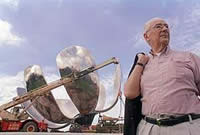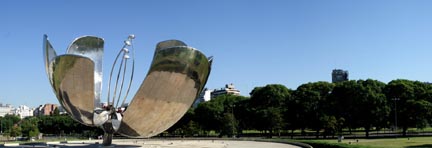Why is the relationship between architecture and visual art so persistent in Argentineans? Clorindo Testa may be the most successful visual art and architect to live since Le Corbusier. Visual artist Guillermo Kuitca’s paintings breathe in the dark space of the theater. As a public artwork, Kuitca interpreted the DPZ site plan for Miami’s Aqua Development in 2005. Emilio Ambasz haunts in imaginary world between poet, earth artist and architect. From Uruguay, but raised and educated as an architect in Buenos Aires, Volf Roitman recently completed the MADI Museum in Texas. Cesar Pelli provides the space for art to sing at least since the celebrated public art at his Battery Park City in the 1980s and recently at the 2006 Carnival Performing Arts Center in Miami. University of Miami architecture professor, Roberto Behar with his partner Rosario Marquardt, continue to produce some of best permanent and temporary urban interjections in the world.

Researching the Flower of Buenos Aires, another Argentine architect – Eduardo Catalano – emerges as the artist. And not just any architect, but yet another designer sparked to artistic complexity by Walter Gropius. Catalano completed his architectural studies at Harvard in 1945 and later move to the USA in 1950 to join an amazing faculty at North Carolina State University that included Buckminster Fuller, Matthew Nowicki and Lewis Mumford. The hyperbolic parabaloid roof of his 1954 home was a product of this creative environment. Unfortunately, the house was demolished in 2001 like so many tiny masterpieces of modernism by underrecognized architects around the USA.
He moved on MIT with the brilliant Pietro Belluschi another underrecognized master that HAS achieved protection for his work in the Pacific Northwest. Together, they designed Julliard School of Music and Alice Tully Hall in NYC now under renovation by Diller Scofido + Renfro (Another creative team of the artist / architect variety).

So at 82 years old in 2002, Catalano designs, produces and installs the sculpture, “Floralis Genérica“, behind the National Museum of Fine Arts in Buenos Aires. (Testa, now 84 himself, continues to produce exhibitions of paintings and sculptures) The flower is no simple construction for all its simplicity of form. The 18 tons of aluminum and stainless steel was manufactured by Lockheed Martin Aircraft Argentina. Through hydraulic mechanics, the 13-meter tall pedals move to open and close in the morning and evening each day. Fully open, the flower spans nearly half a football field at 40 meters in diameter. Closed the sculpture is 20 meters high.
Unlike Anish Kapoor’s 2005 “Cloud Gate“ in Chicago, the art is lonely. (Type “Floralis Genérica, Buenos Aires” into Google Earth for the site and variety of photos.) In a city swarming with 12 million people, the Plaza of the United Nations is empty and cut off from the city by wide rivers of traffic. Unlike Cloud Gate that absorbs architectural Chicago in the polished surfaces, Floralis Genérica (Generic Flower) reflects a generic green landscape and gray or blue skies that could be anywhere. Cloud Gate pulls the visitor to an intimate play with images of self and city. Floralis Genérica pushes the visitor to view the full sculpture and engages the visitor in a psychological conflict between pop icon and subtle observation of every surface. Cloud Gates elevated plaza accentuates its importance and place, while Floralis Genérica struggles in nowhere. The flower should be the winner in the contest of icon making, but the bean’s 360-degree crisp image of the city has the photographic clarity lost in the flower. Location, location, capture the location.
The sculpture is located at the Plaza Naciones Unidas at the intersection of Figueroa Alcorta y Tagle near the Recoleta Cultural Complex.
Cloud Gate is 30 meters long and 10 meters high. Floralis Genérica is 40 meters in diameter and 20 meter high. Cloud Gate cost $23 million. Floralis Genérica rumored to cost $4.5-6 million as a private donation by Catalano himself.
Public Art, Public Space

amazing